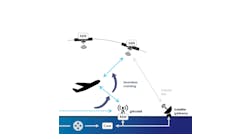From The FAA: NextGen
Did you know that when night flying for the Post Office was inaugurated between New York and Chicago in 1925, some system upgrades had to be made to assure safe flight? These improvements included: 289 flashing gas beacons, 17 planes with luminous instruments and parachute flares, five lighted terminal fields for primary and alternate landings, and 34 emergency landing fields along the route; that was initially for just one flight per night. It was the Roaring Twenties version of NextGen.
NextGen upgrades will be implemented into the Air Traffic Control (ATC) systems by 2020. These changes remove the guesswork from air-to-ground communications and assure expedient routes between airports; they’ll improve in-flight weather problem analysis; and foresee air-to-air traffic snarls that’ll provide the aircraft with corrections to avoid collisions both in-air and on the ground. In short, NextGen will be the eyes, ears, and decision-maker for all aircraft movements.
Automatic dependent surveillance broadcast (ADS-B)
According to the FAA NextGen performance standard, “All aircraft must be equipped with ADS-B by 2020 to fly in controlled airspace.”
NextGen’s purpose: incorporate these advances to improve efficiency, safety, and increase tracking, while intensifying information sharing in the National Airspace System (NAS). ADS-B will facilitate the direct routing of aircraft, while optimizing countless departures and approaches. It assists in tracking aircraft more efficiently; this increases capacity, while saving time and fuel. NextGen is a proactive approach to increasing aviation safety.
ADS-B broken down means automatic, being that the message element repeatedly “squitters,” or broadcasts, once per second; the message element is the information being transmitted, e.g. position, altitude, aircraft dimensions, etc., that contains the information for ATC to provide services. It is dependent as it relies on GPS (presently) for position; the rule doesn’t dictate ‘GPS’, but the system must be accurate. Surveillance as it provides information to ATC to determine who you are. Finally, broadcast … well, that’s self-explanatory. Like all technologies, it’s intended to be a fluid technology, i.e. its implementation and use is dictated by any events that could affect global aviation.
The further an aircraft is from a radar antenna, the more the accuracy degrades. However distance from an ADS-B ground station has no effect on ADS-B accuracy because it uses satellite-based position data. ADS-B allows tracking of aircraft, both fixed wing and rotorcraft, in many geographical locations; all ADS-B ground stations will be installed by 2013. While radar coverage is limited, ADS-B accurately follows aircraft flying over, say, the Gulf of Mexico with stations located on oil drilling platforms; they’ve a range of 200 nautical miles. Active ADS-B ground stations are in Louisville, KY; Houston, TX; the Florida peninsula; and Philadelphia, PA.
ADS-B systems provide information for both properly equipped aircraft and ATC, which is accomplished by ADS-B ‘IN’ and ADS-B ‘OUT’. The term ADS-B OUT speaks to the data that is broadcast from the aircraft and is used by ATC to locate and identify aircraft; ADS-B OUT is the only functionality mandated by 14 CFR 91.225 and 91.227. ADS-B IN is a situational awareness tool for the aircraft; it allows the aircraft to see other aircraft around it and displays this information for the pilot(s). ADS-B IN is optional; it’s not included in the regulations.
The equipment
Equipment-wise, ADS-B is a separate entity from the transponders being used on most aircraft today. On air carrier aircraft it can be a single box unit that houses the ADS-B, Transponder Mode S and TCAS or it can be a stand-alone datalink processor that interfaces with other systems. In GA aircraft it can be a universal access transceiver (UAT), but there won’t be stereotypical ADS-B equipment. The installation of an ADS processor in a line replaceable unit will need to interface with input components like a global positioning system (GPS), flight management computer (FMC), and air data computer (ADC). If the aircraft is currently operating with a GPS and Mode S at 1,090 Megahertz (MHz), it will interface with them.
ADS-B is available on two bands: 1,090 MHz is mandated for all aircraft operating in Class A airspace above 18,000 feet, while 978 MHz is available in all other ADS-B controlled airspace (Classes B, C, and E above 10,000 feet); 978 MHz is the UAT, which is a wide band multipurpose data link operating on a single channel. It is being offered to the GA folks to curb the oversaturation of 1,090 MHz. One incentive for someone going to UAT is the Flight Information Services-Broadcast (FIS-B); it will provide weather, NOTAM messages, etc. FIS-B is available only to UAT-equipped aircraft.
The avionics technicians will need to set up and test each aircraft’s ADS-B system; every ADS-B equipped aircraft will be assigned a 24-bit address by the International Civil Aviation Organization (ICAO). This address will be used by ground operations to identify the specific aircraft; the address may either be programmed at the avionics bench in the shop or at the rack while installed on the aircraft.
As with a transponder, ADS-B will be used to locate and track an aircraft. However while the transponder enables ground to interpret bearing, range, and altitude via primary and secondary radar signals, ADS-B translates information from multiple sources, e.g. GPS, ADC, and the FMC. The ADS-B then transmits the multiple interrogations it receives into a solitary strand of “single-language” data to the ground.
Maintenance aspects
Aircraft technicians will see an increase in available manufacturers’ training as industry catches up. It’s still early on for this article to specify what type(s) of training will be available, so let’s look at what the needs of some systems should be. Since the ADS-B inputs are dependent on each other, the maintenance will not be limited to component replacement. Returning the ADS-B system to service is a total system check; if the system is disturbed and/or the replaced component(s) have a dedicated input to the ADS-B, full system testing of the ADS-B will need to be accomplished as well as the source systems, e.g. TCAS, GPS, etc. These system tests resemble the maintenance requirements for returning a CAT II/CAT III lower landing minima-equipped aircraft to service; this knowledge requires initial systems training and requalification training every year.
How will the AMT modify an aircraft? The manufacturers are still improving the technology; on most general aviation (GA) aircraft (and some commercial aircraft) the modifications include replacing or upgrading transponders and/or antennas.
According to the aircraft and the systems presently in place, rewiring is necessary to upgrade the aircraft. Initially, installation approvals will be through type certificate (TC), amended TC, and supplemental type certificates (STC) and not through local field approvals; the STC process usually works through the FAA Aircraft Certification Offices. There are already several ADS-B STC installations approved for helicopter, turboprop, and commercial jet aircraft; these include fitting of antennas, trays, wiring, transponders, and cockpit traffic displays.
According to Advisory Circular 120-86, “ADS-B link systems will consist of a combination of the 1090 Extended Squitter (ES) link for air carrier and private/commercial operators of high performance aircraft, and UAT, to be used primarily by GA.”
Delays
Now not everyone will jump into NextGen with both feet; several factors have dictated the industry’s inclination to have their equipment upgraded. The recession has hit everyone hard, whether they’re GA, air taxi, or scheduled service, with some hit harder than others; the money is just not there at this time. Although the FAA target date is 2020 for full NextGen spool-up, some operators and pilots will delay their entry into NextGen, determined not to buy into present day systems that could be antiquated by 2020. And then there are some who will see how the economy does to determine if they’ll even be around by 2020. Whatever the reason, 10 years is a long time for the world to change and technology to improve.
Go to www.faa.gov for NextGen information and links. To view the new rules, go to: http://edocket.access.gpo.gov/2010/pdf/2010-12645.pdf. AMT
Stephen Carbone is an aviation industry veteran of 28 years. He works at the Boston regional office in the Flight Standards Airworthiness Technical Branch. He holds a master’s degree in aviation safety systems.


